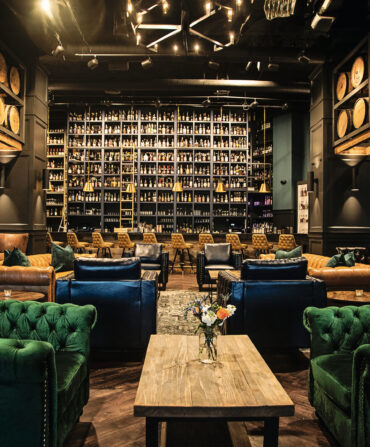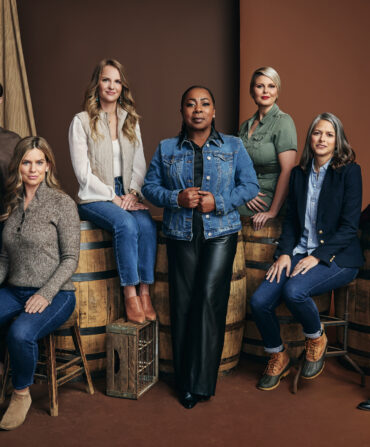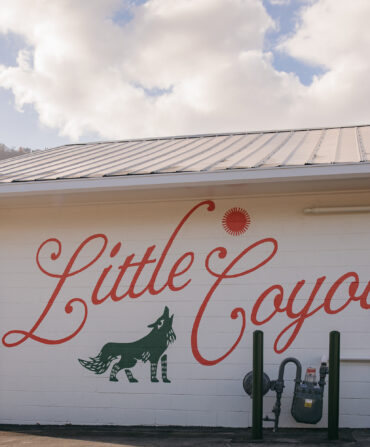Food & Drink
Nina Compton: Hare Apparent in New Orleans
Compton’s ethereal Compère Lapin—arguably the hottest restaurant in town and named for the Br’er Rabbit of her Caribbean upbringing—is a case study in the push and pull of tradition, and the boundless future of Crescent City cuisine
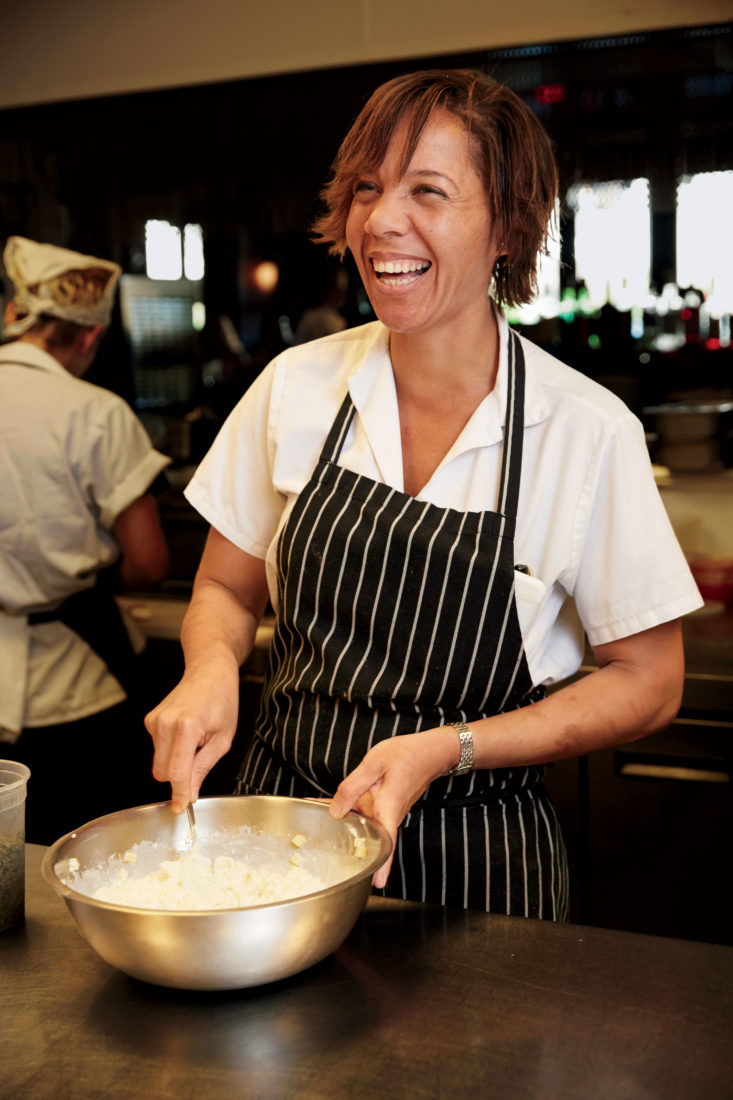
Photo: MELANIE ACEVEDO
“We don’t make gumbo. No way.”
Nina Compton is standing in the kitchen of her New Orleans restaurant, Compère Lapin, wielding a hacksaw—the antithesis of the delicate tweezers that have lately become the emblematic chef’s tool. She’s using the saw to calmly but emphatically dismantle a side of goat that’s just come in, running the blade between the ribs, applying pressure when necessary to break through bone, peeling off slabs of pink flesh and then tossing them into a white plastic container filled with brine. Nobody is about to start arguing with her about gumbo, or anything else.
But in some ways New Orleans is always in a discussion about gumbo. All the traditional arguments, of course—who makes it best; filé, okra, or roux; what shade of roux; and so on—but also a more existential debate about what “New Orleans food” means when some of its most famous new restaurants have no intention of serving its most famous dish.
The past five years have been an especially fertile time for new New Orleans restaurants playing on the national stage. The Israeli restaurant Shaya and Gulf-seafood-centric Pêche both beat out competition in places like New York and San Francisco to be named Best New Restaurant at the James Beard Awards. Compton, too, was a Beard finalist this year, for the category of Best Chef: South, as well as a Food & Wine Best New Chef. One thing that sets Compère Lapin apart is that, unlike the others, it arrived unattached to any long-standing local restaurant group. Another is how quickly and effortlessly it has insinuated itself into the city’s own internal roster of beloved institutions, and into the ongoing—with no exaggeration, centuries-long—conversation about the definition of Creole cuisine. Last year, the Times-Picayune restaurant critic Brett Anderson named Compère Lapin Restaurant of the Year, his first ever such designation. All this from a chef who, aside from several weeks spent competing on Top Chef, had barely set foot in the Crescent City before arriving to open her restaurant.
And yet, Compton insists, she knows her limits: “Are you kidding?” she says, reaching into the goat’s body cavity and plucking out a swollen ball of kidney, later to be used in a Bolognese. “If I made gumbo, they’d tear me apart!”
There are rabbits all over the apartment that Compton shares with Larry Miller, her husband and business partner, and with their two dogs, Rocky and Hank. It’s a two-bedroom loft with ex-posed brick walls in a converted rice mill, hard by the sharp bend where the Mississippi River exits New Orleans and rushes toward the Gulf of Mexico, and it has the feel of being occupied by two people who spend most of their time at work. The persistence of rabbits—sculptures, figurines, drawings, postcards, and more—is the inevitable result of opening a restaurant named Compère Lapin, or “Brother Rabbit.”
“Actually, I prefer horses,” Compton says, with a shrug. “But people keep buying me these.”

Photo: MELANIE ACEVEDO
One of the many rabbit figurines given to Compton sits on the bar.
The name pays tribute to the trickster character, known most famously as Br’er Rabbit, who pops up in folktales in both Compton’s adopted home in Louisiana and her native country of St. Lucia, one of the many connections she’s made between two places that share a vast amount of often tragic cultural history—from French colonialism to the African slave trade.
“Larry said, ‘People won’t be able to pronounce it. They’ll butcher the name,’” Compton recalls. “I said, ‘No. I need to find a way to use this. To bring these places together.’” (It is, for the record, pronounced kom-pare la-pan.)
That disagreement notwithstanding, Miller and Compton are a simpatico team. In an era of kitchen dominance, he is a smooth and committed front-of-house pro, the team’s social-media face, and his wife’s indefatigable, not to say gooey-eyed, supporter. They met while both were working at Miami’s Casa Casuarina, a high-end boutique hotel and event space in the former Versace mansion. Their courtship was a kind of South Beach Rashomon: Miller was instantly smitten by the chic young woman he saw arriving and departing as early and late as he did each day, and whose laughter he could hear coming out of the kitchen across the courtyard from where he sat eating lunch at his desk. Compton remembers thinking, “Who is this goofy white guy?” He was persistent, finally winning a date when he bought Compton a copy of the book The Fourth Star, about life at the restaurant Daniel, in New York, where Compton had worked after culinary school. “It showed he’d actually paid attention when I talked,” Compton says.

Photo: MELANIE ACEVEDO
Compton with her husband and business partner, Larry Miller.
It was Miller who first met with the owner of the space that would house Compère Lapin—a raw construction site on the ground floor of what would become the Old No. 77 Hotel & Chandlery. This was three years ago, in the wake of Compton’s second-place showing on Top Chef. (She won the postseason Fan Favorite award.) Offers were pouring in at a bewildering pace. “People were like, ‘Fly here. Fly here,’” she says. “I was doing events on all my off days—New York, London, Slovenia, Italy—then flying back, putting my suitcase in the office, putting on my chef’s jacket, and doing service.” She was in Toronto when Miller called, saying he might have found the perfect spot for their own restaurant.
“Would you consider moving?” he asked.
“Absolutely not,” Compton said.
“What do you think of New Orleans?” Miller replied.
“Tell me more,” Compton said.
It’s hard to imagine a more strained and artificial introduction to a city than the managed life of a reality-show contestant, but New Orleans has a way of infecting visitors, and Compton’s few weeks shooting Top Chef had apparently provided sufficient exposure. “It was the music, the architecture,” she says. “If you look at pictures of St. Lucia back in the day, some of the buildings are the same: the wooden cottages, the colorfulness of the houses. It felt like home.”
In Miami, a successful restaurant was defined by its high-flying clientele. When Compton helped open a branch of the New York Italian restaurant Scarpetta, in the Fontainebleau hotel, Mariah Carey, Alex Rodriguez, and Mikhail Gorbachev all came for lunch the first day—surely as surreal a guest list as has ever existed. In New Orleans, she imagined something different.
“I didn’t want to be this hotshot chef coming in from Miami to show off,” she says. “That’s not how people are here. I wanted to be very respectful.” The hotel pressed Miller and Compton to open by New Year’s Eve, but they resisted, opting instead to debut in the notoriously slow month of June. “They said, ‘Nobody is going to be here,’” Miller says. “We were like, ‘Except all the people who live here and who we want to meet!’ We had no friends and wanted to meet locals. That was the whole point.” He estimates that Compère Lapin’s customers, despite the national attention, are 70 percent New Orleanians—no small feat for a restaurant located near the convention center, where locals fear to find parking.

Photo: MELANIE ACEVEDO
Hanging out at the restaurant’s bar.
All this talk of respect, fitting in, and who gets to cook what may seem weird at a time when chefs regularly set up shop in new cities and culinary globalism reigns supreme. But the reality is complicated in the Big Easy, as it prepares to celebrate the dawn of its fourth century. (Come 2018, it will be three hundred years since Jean-Baptiste Le Moyne, Sieur de Bienville, named a crescent-shaped patch of the Mississippi River bank after his patron, the Duke of Orléans.) It’s no secret that change has come fast and furious over the past decade or so, beginning, of course, with the existential threat that was Hurricane Katrina and its aftermath. The years that followed saw an influx of new residents, many of them young, professional, and creative, from all over the country. With them came a familiar worry—that those drawn to the city for the culture that defines New Orleans as the least “American” city in America would, by their very presence, dilute that culture, perhaps even fatally.
It’s a very New Orleans paradox—at once cosmopolitan and provincial. The essential narrative of the city, and its cuisine, stems from the tension between assimilation and identity: African, Native American, French, Spanish, Irish, Sicilian, and Cajun, to tick off just a few of the influences contained in that slipperiest of terms, “Creole.” Just like this most recent one, many of those waves of immigration resulted from unhappy historical forces: imperialism, slavery, war, natural disaster.
“Life has a way of dictating change,” says Frank Brigtsen, whose thirty-one-year-old restaurant, Brigtsen’s, is a standard-bearer for Creole dining in the city. Miller and Compton sought Brigtsen out as a kind of Crescent City mentor upon arriving in New Orleans, and they have become friends. “Creole is a very expandable cuisine,” Brigtsen says. He learned this firsthand working under the legendary Paul Prudhomme as the chef introduced such unheard-of country delicacies as crawfish, frogs’ legs, and cochon de lait into the Creole canon. And yet Brigtsen, too, worries.
“It’s a conundrum: People who move here for the culture, are they good for the culture?” he asks. “If they’re hungry, are they just as likely to go get sushi as to grab a po’boy? And is that okay? I’m afraid that in thirty years, my New Orleans won’t exist.”
Compton understands that concern but also has faith in the city’s ability to maintain its core in the midst of change. She remembers the first Easter after she and Miller arrived in town, when a new acquaintance offered to bring by some crawfish bisque. “I’m like, fine, I’ve had lobster bisque a ton of times. It will probably be like that.” Instead, what arrived was one of the more esoteric and labor-intensive dishes of the South Louisiana food calendar, involving, among other steps, individually stuffing dozens of tiny crawfish heads. “I opened the Tupperware container and I could taste all the layers of flavor. I called and said, ‘Oh my God. How did you make this?’ She said, ‘Oh, it’s a family tradition. My mom cuts the vegetables, someone’s stuffing the heads, someone else is cooking the soup…’ This could be at Bocuse or any Daniel Boulud restaurant, and it’s cooked at somebody’s house. The more I talked to people about the way of life here, the more I saw that’s how it is. So I don’t think that’s going to be diluted.”
Brigtsen, for his part, is sure of one thing. “Nina Compton,” he says, “is every bit as Creole as I am.”
“Great,” Compton says, in response, “but I’m still not making gumbo.”
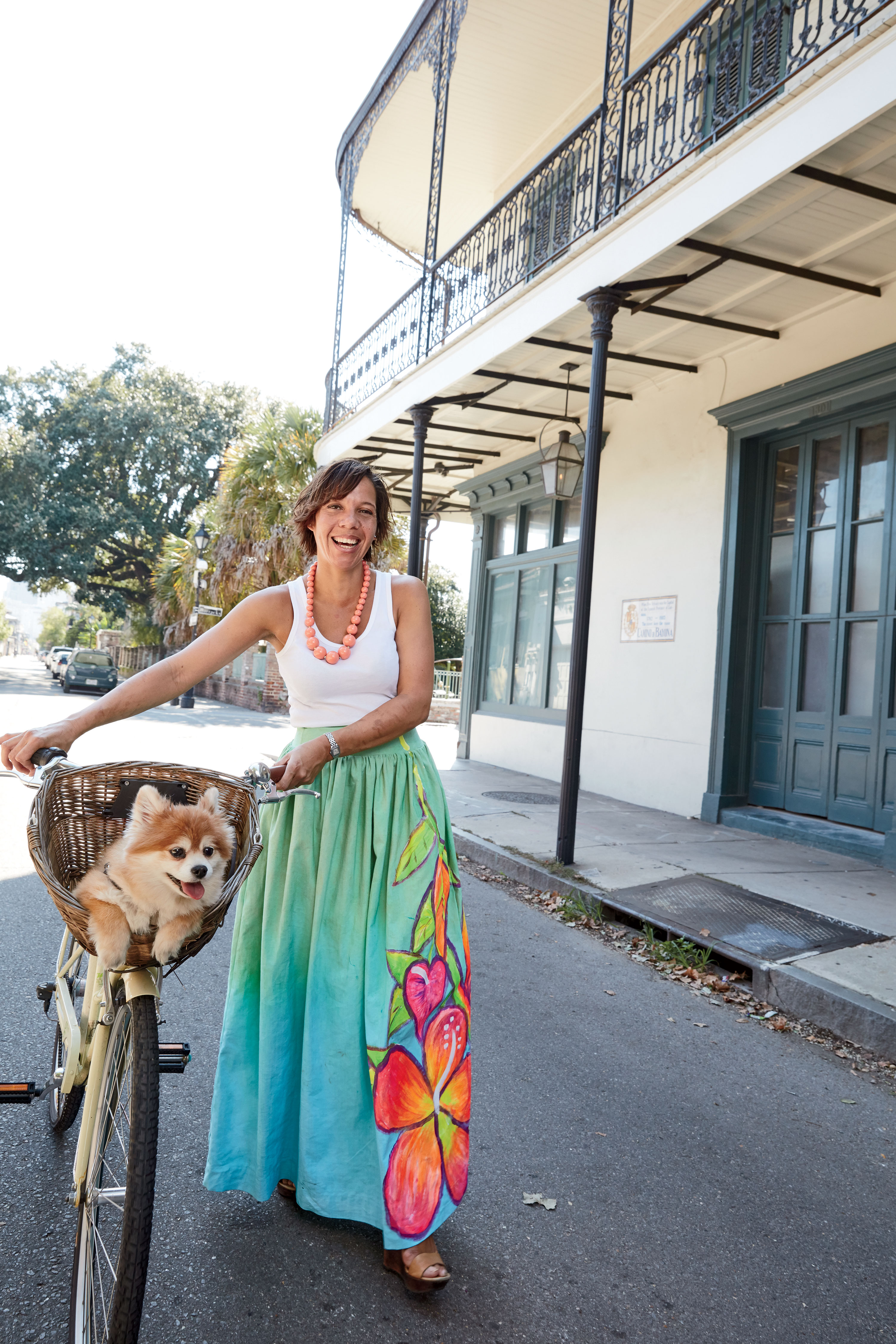
Photo: MELANIE ACEVEDO
The chef with Rocky in the French Quarter.
Compton comes by her ability to bridge worlds honestly. She grew up in St. Lucia the fourth of five children of John Compton, a man she described with characteristic modesty to Miller during their courtship as working “in government.”
“I assumed he worked at the Social Security office or something,” Miller remembers. It turned out that the elder Compton, at eighty-one, was running for prime minister at the time, a post he had already held twice since leading St. Lucia to independence in 1979. (He won and held the job until his death, in 2007.) Originally a champion of the sugar and banana farmers who had long been the driving force of the nation’s economy, John Compton had later overseen St. Lucia’s transition to a tourist destination. In 1997, he was knighted for his efforts, and Nina grew up amid photos of her father with figures like Nelson Mandela and Bill Clinton. Among St. Lucians he is still widely known as Papa.
For all that, John Compton was, by inclination and political instinct, determined that neither he nor his family flaunt their status in their overwhelmingly poor country. A beat-up 1987 Toyota pickup was his signature mode of transportation, and instead of living at the prime minister’s residence in Castries, the capital city, the Comptons were raised in Gros Islet, on the northern tip of the island. The children would walk to and from school, rather than be seen using a driver.
Nina was a tomboy, the sister that neighbors would advise her parents to keep an eye on, lest she stay out past dinnertime playing soccer with the local boys. The family had a cook, but the real boss of the kitchen was Nina’s maternal grandmother, a white British nurse who had met her grandfather while he was serving in Scotland during World War II and moved home with him—an extraordinary step at a time when interracial couples were still an extreme anomaly in colonial island life. She may have adjusted to the islands in many ways—braving, in the early days, plantation life with no electricity, few cars, and limited running water—but food remained her connection to home.
“She made fish and chips,” Compton says. “She loved lamb. Every afternoon she would have her little tea sandwiches, a pot of tea, fresh fruit. She’d make those little sandwiches, and we’d sit down and talk with her. She was basically the chef, and the maid was the sous-chef.”
As her siblings had done before her, Compton left at sixteen to attend boarding school in England. It was thrilling to be on her own, if hard to adjust to the cold, damp, and winter darkness. Compton imagined a future studying agriculture but came home one summer with a different idea.
“I said I wanted to try cooking for a bit,” she says. Her mother, though dubious, found her a two-month gig at the nearby Sandals resort. Compton stayed two years, cycling through every department of the huge hotel kitchen, from bakery to catering. Increasingly convinced that she had found her career path, she left home once again, this time to attend the Culinary Institute of America, ninety miles north of New York City. A high-pressure apprenticeship in the kitchen of Daniel followed, but the pace of New York, not to mention its winters, soon sent Compton south, to Miami. She landed a job with the chef Norman Van Aken, who, along with chefs like Douglas Rodriguez, was at that time creating what people were calling pan-Latin or fusion cuisine. For Compton, it was a revelation. “Everybody [else] was doing French fine dining, and they were going in the opposite direction,” she says. “They were doing Latin flavors, Caribbean flavors. They were using yucca, coconut milk, habaneros, stuff I grew up with. Humble ingredients. Not in my wildest dreams had I imagined that was possible.”
She had moved up to chef de cuisine at Scarpetta when Top Chef came calling, asking her to audition for its eleventh season. By then she had more reason to try out than just exposure. The show offered a chance to break out of a culinary rut.
“European food was always the top of the top,” she says. “That was what was drilled into your head. But I started to feel like I was losing my creative freedom. I thought, ‘I can cook French food for the rest of my life, but do I want to? Or do I want to go back to the things I grew up with, the things that I crave?’”
So, is Compère Lapin a “Caribbean restaurant”?
Back in the kitchen, Compton screws her face up, undecided. The goat carcass is dispatched, and Compton has taken over the job of expediting orders in between shucking oysters, the usual raw-bar staffer having been given the night off. For a chef, she is preternaturally calm, even when a sleepy late-summer dinner service suddenly gets harried. Miller comes in to say that a large table is dallying over cocktails, meaning nearly all the orders in the dining room will most likely come in at once. Compton sighs and calmly rearranges the order tickets hanging on the pass. She knows how to yell, she says, but she strives to create a kitchen atmosphere unlike the kinds of pressure cookers she experienced coming up through fine dining. “I used to feel sick to my stomach coming to work every morning,” she says of her time in New York. “You try to avoid the mistakes you’ve seen in other kitchens.” In any event, Compton’s cooks seem as attuned to the frequency of her voice as a baby to his mother’s; even amid the kitchen din, she rarely has to raise it.
Compton inspects a plate heading out, a trio of pork preparations nestled between bright yellow beets and a deep red sour-cherry jus. It is a dish that would be at home on any modern, seasonal New American menu.
“It’s not like we’re serving jerk chicken,” she says, still mulling the question of categorizing the restaurant. Indeed, French, Italian, Mediterranean, Southern, and other influences abound on the menu, all imbued with Compton’s classical training. Still, it’s the flavor palette of her home island that animates the kitchen’s most exciting entries: the shrimp, poached in a classic court-bouillon and then pickled with jalapeño, cilantro, and lime; the semifreddo made with custardy soursop, covered by a snowfall of freeze-dried coconut and ribbons of cucumber and celery leaves. Jerk spices do in fact make an appearance, on the crisp skin on a fillet of black drum (which may truly be the official fish of the Crescent City, even if its cousin redfish gets all the press). These are dishes that taste at once familiar, of their place, and like nothing New Orleans has ever had before.
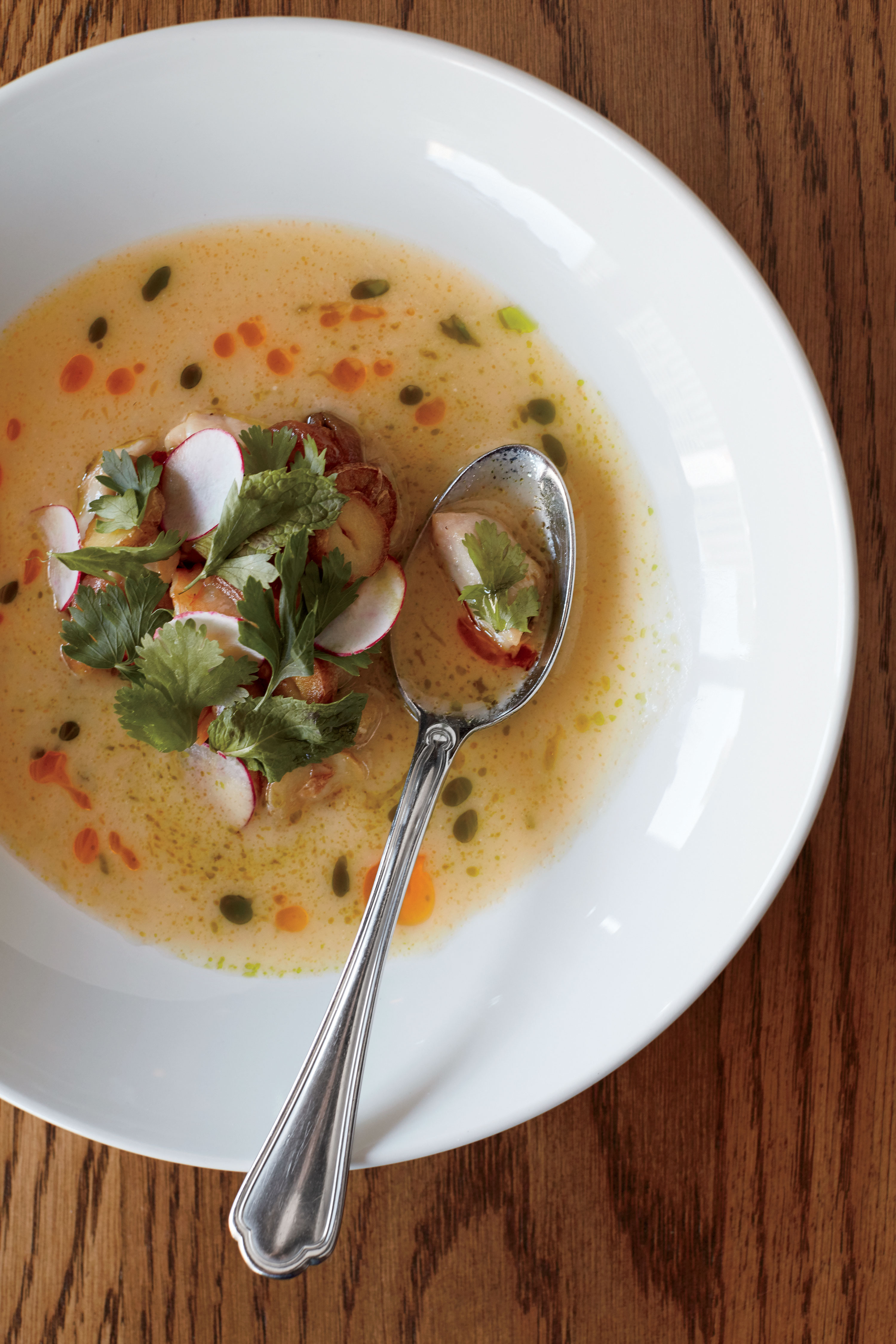
Photo: MELANIE ACEVEDO
Caribbean seafood pepper pot, a soup made with sunchokes, shellfish stock, ginger, lemongrass, habaneros, and coconut milk and poured tableside over Gulf seafood.
And then there’s that goat, which has become the restaurant’s signature dish: After brining, it is braised, shredded, and served with sweet potato gnocchi beneath a blanket of deep brown cashew and coconut curry. Before she opened, Compton worried about whether she could get people to try goat. She started off buying one goat per week; the restaurant now goes through six.
It is a warming, nurturing dish and, in this, Compton grudgingly allows, not totally unlike a certain stew-like soup that’s synonymous not only with New Orleans but with disparate elements coming together to form a more beautiful whole.
“No gumbo,” Compton says, in case someone might be getting any ideas about how far she’s willing to go.
That’s okay. When she’s ready, her city will be, too.


